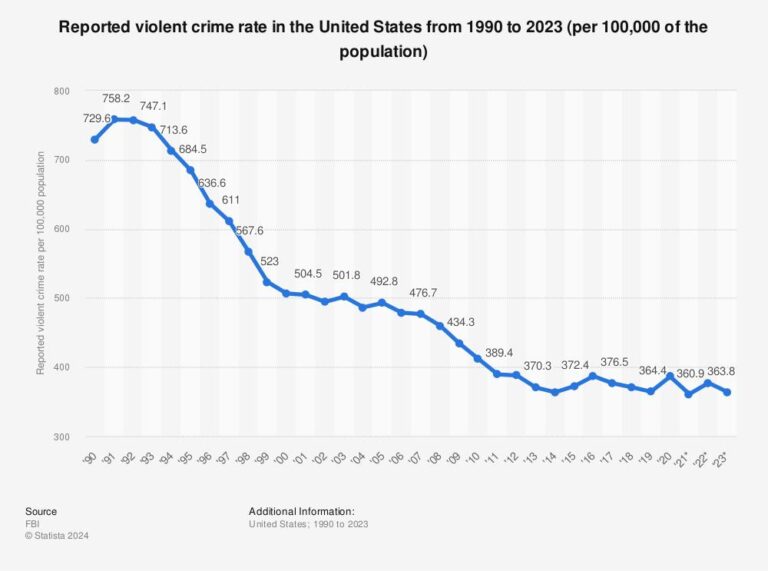Understanding the Decline in Violent Crime and the Public’s Perception in the U.S.
Marked Reduction in Violent Crime Across Key American Cities
Recent statistics highlight a substantial downturn in violent crime rates throughout numerous prominent U.S. metropolitan areas. Cities historically challenged by elevated levels of homicide, assault, and robbery have experienced declines reaching up to 20% compared to prior years. This encouraging trend is largely credited to a blend of enhanced community policing efforts, increased funding for social support services, and the integration of cutting-edge crime analytics technologies. Despite these improvements, many citizens remain doubtful or unaware of the positive changes reflected in the data.
Primary contributors to this decline include:
- Strengthened community involvement programs
- Implementation of predictive policing and data analytics
- Broadened availability of mental health and substance abuse resources
- Improved coordination between local law enforcement and federal agencies
| City | Percentage Decrease in Violent Crime | Year |
|---|---|---|
| Chicago | 18% | 2023 |
| New York City | 22% | 2023 |
| Los Angeles | 15% | 2023 |
| Houston | 17% | 2023 |
Why Public Opinion Often Contradicts Crime Statistics
Although data clearly indicates a downward trajectory in violent crime rates, public opinion frequently diverges, with many Americans perceiving crime as escalating or remaining a significant threat. This disparity stems from several influences, including sensationalized media coverage that spotlights isolated violent events, and the psychological weight of personal or community experiences that overshadow broader trends.
Experts identify key reasons behind this perception gap:
- Media Influence: Persistent exposure to dramatic crime reports heightens fear despite overall crime reductions.
- Localized Crime Variability: Certain neighborhoods may face rising crime, skewing general public impressions.
- Institutional Distrust: Skepticism toward law enforcement and government data undermines confidence in official crime statistics.
| Year | Violent Crime Rate (per 100,000 people) | Percentage of Public Believing Crime is Increasing |
|---|---|---|
| 2018 | 410 | 65% |
| 2019 | 385 | 67% |
| 2020 | 350 | 70% |
| 2021 | 320 | 72% |
Key Drivers Behind the Nationwide Drop in Violent Crime
The notable reduction in violent offenses across the U.S. over the last twenty years can be attributed to a multifaceted set of influences. Innovative policing methods, including the use of data analytics and community-focused strategies, have enhanced law enforcement effectiveness. Concurrently, social initiatives aimed at youth intervention have played a critical role in steering vulnerable populations away from criminal behavior. Economic factors such as declining unemployment and expanded educational opportunities have also mitigated some underlying causes of violence.
Technological progress has further transformed crime prevention and resolution. Enhanced surveillance tools, improved emergency response systems, and legislative reforms targeting drug trafficking have reshaped the criminal landscape. Public education campaigns on violence prevention have increased awareness, contributing to safer communities. Together, these elements form a comprehensive framework supporting the ongoing decline in violent crime.
| Influential Factor | Effect on Crime Reduction |
|---|---|
| Community-Oriented Policing | Enhanced trust and cooperation between police and residents |
| Youth Engagement Programs | Lowered gang involvement and juvenile offenses |
| Technological Innovations | Accelerated crime detection and resolution |
| Economic Development | Reduction in poverty-related criminal activity |
| Policy and Legal Reforms | Disruption of illicit drug networks |
Enhancing Community Trust Through Transparency and Engagement
Rebuilding public confidence in law enforcement hinges on transparent practices and active community involvement. Police departments nationwide are increasingly adopting tools such as body cameras, publicly accessible crime data portals, and real-time mapping of incidents to foster openness and accountability. These initiatives help demystify police operations and align public understanding with factual crime trends.
Equally important is cultivating genuine partnerships with community members. Law enforcement agencies are expanding efforts to collaborate with local organizations, facilitate town hall discussions, and establish neighborhood liaison programs. These approaches empower residents to participate in safety planning and crime prevention, strengthening mutual trust. Successful community engagement often includes:
- Regular public meetings to address concerns and share progress
- Interactive workshops that involve citizens in developing safety strategies
- Youth outreach initiatives designed to build lasting relationships
| Program | Focus Area | Measured Outcome |
|---|---|---|
| Expanded Neighborhood Watch | Crime Deterrence | 18% Decrease in Residential Burglaries |
| Youth Police Leadership Academy | Education and Engagement | Over 5,000 Youth Participants Annually |
| Citizen Advisory Boards | Policy Development | 40% Rise in Community Satisfaction Ratings |
Conclusion: Aligning Reality with Public Perception for a Safer Future
While violent crime rates continue to fall significantly across the United States, the persistent gap between statistical evidence and public perception presents a complex challenge. Bridging this divide is essential for policymakers, community leaders, and media outlets to foster informed discussions and effective safety strategies. The encouraging data offers hope, but closing the trust gap will be vital in shaping a more secure and united society moving forward.




